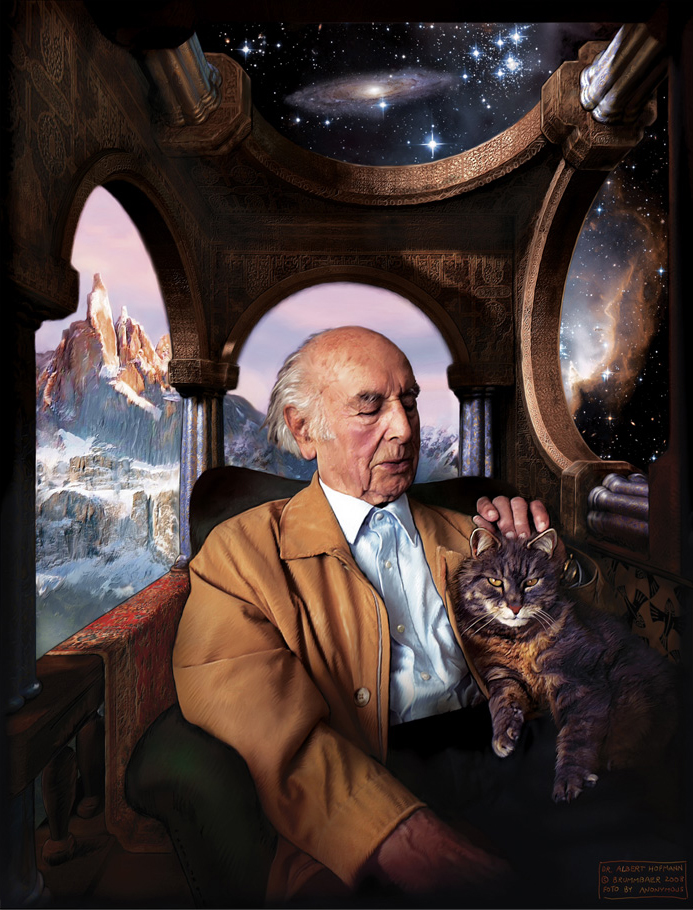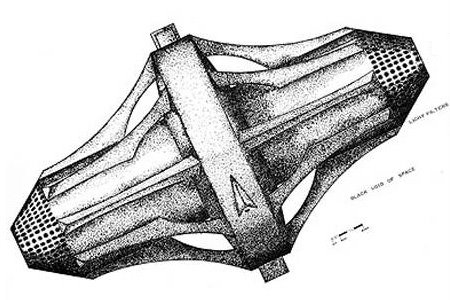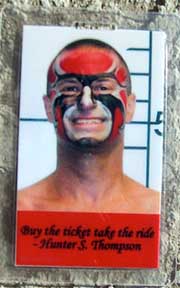Tag: Ecodelics
WIT, william irwin thompson surfaces! with his journal
WIT! william irwin thompson's journal!
On Religion and the State 4/26/2008
For as long as it takes a Tyrannosaurus Rex to devolve into a chicken, just so long will we have to wait for religion to scale down into a harmless nourishment for the soul. Then again, considering cock fights in Latin America, maybe the chicken isn't so chicken after all. It is just smaller than we are. So how long do we have to wait before religion becomes spiritually smaller than we are? Judging by the recent exposures of the geriatric fundamentalist Mormon sect in Texas and the Pope's recent damage control on priests' child molestation, we have a long wait ahead of us. continued here
LSD wrap-up after Hofmann de-animates by John Walsh and bad brains and bad trops
by John Walsh
"Bicycle Day", 19 April, was later commemorated by acid enthusiasts because it was the first conscious "trip" and it had had – just about – a happy ending. But the doors to perception are, for some truth-seekers, booby-trapped and dangerous. When LSD was co-opted by medical staff for recreational use, two decades after Hoffman's bike ride, users learnt the hard way how impossible it was to control the wild ride once it had started.
At Oxford in the early 1970s, we were frankly intimidated by the drug's reputation. We all wanted to try it, but were too chicken. The word in the quad was: if you had any secret hang-ups, mental instabilities, phobias, sexual inadequacies or social insecurities (the kind that surface in dreams,) you were wise of steer clear of acid. We knew when one of us was going to try it. "Tonight," I'd hear during dinner in hall, "Roger's tripping for the first time. But he'll have Will and Ollie with him, so he'll be OK."
I've always remembered Roger's first trip (so, I'll bet, has he). We all knew he'd be fine because he was so perfect: cool, handsome, easy-going, a hit with the girls, a dead ringer, with his corkscrewy curls, for Marc Bolan of T. Rex. And he was rich; he owned a Morgan, which he casually parked in the back quad. We knew Roger would survive the experience and bang on about it, like he banged on about his Bang and Olufsen state-of-the-art hi-fi.http://tinyurl.com/4kc8fl 
JLL writes on Tantra over at metahistory
JLL
Full-body Kundalini
I will begin by saying that I consider the Tantra of my predilection to be integral with Gaian shamanism. This is the telestic shamanism of the Mysteries, aimed at direct communication with Gaia, whose body is the planet earth. Gaia-Sophia, to give her full name, is the matrix of supersensory emotive intelligence that animates the natural world and all its creatures, including human beings. http://www.metahistory.org/TantraTenderness1.php  plenty more images herehttp://www.shunya.net/Pictures/NorthIndia/Khajuraho/Khajuraho.htm
plenty more images herehttp://www.shunya.net/Pictures/NorthIndia/Khajuraho/Khajuraho.htm
old Media on Hofmann's de-animation 1906-2008
this AM 30 Azid_Tao, 00,070 a.L. ( after LSDNATOM) . Saint Hofmann created LSD in Nov., 1938, so why not have this be the cusp of the change over of Epoch's? The most recent 10,000 year era ends and the New Epoch we are in starts with 00,001 for 1939? FERMI does the first nuclear pile in Dec. 1942. Hofmann discovers the effects of Azid_Tao in April , 1943….
and from the NYTimes this AM
Albert Hofmann, the Father of LSD, Dies at 102
PARIS – Albert Hofmann, the mystical Swiss chemist who gave the world LSD, the most powerful psychotropic substance known, died Tuesday at his hilltop home near Basel, Switzerland. He was 102.
The cause was a heart attack, said Rick Doblin, founder and president of the Multidisciplinary Association for Psychedelic Studies, a California-based group that in 2005 republished Dr. Hofmann's 1979 book "LSD: My Problem Child."
Dr. Hofmann first synthesized the compound lysergic acid diethylamide in 1938 but did not discover its psychopharmacological effects until five years later, when he accidentally ingested the substance that became known to the 1960s counterculture as acid.
He then took LSD hundreds of times, but regarded it as a powerful and potentially dangerous psychotropic drug that demanded respect. More important to him than the pleasures of the psychedelic experience was the drug's value as a revelatory aid for contemplating and understanding what he saw as humanity's oneness with nature. That perception, of union, which came to Dr. Hofmann as almost a religious epiphany while still a child, directed much of his personal and professional life.
Dr. Hofmann was born in Baden, a spa town in northern Switzerland, on Jan. 11, 1906, the eldest of four children. His father, who had no higher education, was a toolmaker in a local factory, and the family lived in a rented apartment. But Dr. Hofmann spent much of his childhood outdoors.
He would wander the hills above the town and play around the ruins of a Hapsburg castle, the Stein. "It was a real paradise up there," he said in an interview in 2006. "We had no money, but I had a wonderful childhood."
It was during one of his ambles that he had his epiphany.
"It happened on a May morning – I have forgotten the year – but I can still point to the exact spot where it occurred, on a forest path on Martinsberg above Baden," he wrote in "LSD: My Problem Child." "As I strolled through the freshly greened woods filled with bird song and lit up by the morning sun, all at once everything appeared in an uncommonly clear light.
"It shone with the most beautiful radiance, speaking to the heart, as though it wanted to encompass me in its majesty. I was filled with an indescribable sensation of joy, oneness and blissful security."
Though Dr. Hofmann's father was a Roman Catholic and his mother a Protestant, Dr. Hofmann, from an early age, felt that organized religion missed the point. When he was 7 or 8, he recalled, he spoke to a friend about whether Jesus was divine. "I said that I didn't believe, but that there must be a God because there is the world and someone made the world," he said. "I had this very deep connection with nature."
Dr. Hofmann went on to study chemistry at Zurich University because, he said, he wanted to explore the natural world at the level where energy and elements combine to create life. He earned his Ph.D. there in 1929, when he was just 23. He then took a job with Sandoz Laboratories in Basel, attracted by a program there that sought to synthesize pharmacological compounds from medicinally important plants.
It was during his work on the ergot fungus, which grows in rye kernels, that he stumbled on LSD, accidentally ingesting a trace of the compound one Friday afternoon in April 1943. Soon he experienced an altered state of consciousness similar to the one he had experienced as a child.
On the following Monday, he deliberately swallowed a dose of LSD and rode his bicycle home as the effects of the drug overwhelmed him. That day, April 19, later became memorialized by LSD enthusiasts as "bicycle day."
Dr. Hofmann's work produced other important drugs, including methergine, used to treat postpartum hemorrhaging, the leading cause of death from childbirth. But it was LSD that shaped both his career and his spiritual quest.
"Through my LSD experience and my new picture of reality, I became aware of the wonder of creation, the magnificence of nature and of the animal and plant kingdom," Dr. Hofmann told the psychiatrist Stanislav Grof during an interview in 1984. "I became very sensitive to what will happen to all this and all of us."
Dr. Hofmann became an impassioned advocate for the environment and argued that LSD, besides being a valuable tool for psychiatry, could be used to awaken a deeper awareness of mankind's place in nature and help curb society's ultimately self-destructive degradation of the natural world.
But he was also disturbed by the cavalier use of LSD as a drug for entertainment, arguing that it should be treated in the way that primitive societies treat psychoactive sacred plants, which are ingested with care and spiritual intent.
After his discovery of LSD's properties, Dr. Hofmann spent years researching sacred plants. With his friend R. Gordon Wasson, he participated in psychedelic rituals with Mazatec shamans in southern Mexico. He succeeded in synthesizing the active compounds in the Psilocybe mexicana mushroom, which he named psilocybin and psilocin. He also isolated the active compound in morning glory seeds, which the Mazatec also used as an intoxicant, and found that its chemical structure was close to that of LSD.
During the psychedelic era, Dr. Hofmann struck up friendships with such outsize personalities as Timothy Leary, Allen Ginsberg and Aldous Huxley, who, nearing death in 1963, asked his wife for an injection of LSD to help him through the final painful throes of throat cancer.
Yet despite his involvement with psychoactive compounds, Dr. Hofmann remained moored in his Swiss chemist identity. He stayed with Sandoz as head of the research department for natural medicines until his retirement in 1971. He wrote more than 100 scientific articles and was the author or co-author of a number of books
He and his wife, Anita, who died recently, reared four children in Basel. A son died of alcoholism at 53. Survivors include several grandchildren and great-grandchildren.
Though Dr. Hofmann called LSD "medicine for the soul," by 2006 his hallucinogenic days were long behind him, he said in the interview that year.
"I know LSD; I don't need to take it anymore," he said, adding. "Maybe when I die, like Aldous Huxley."
But he said LSD had not affected his understanding of death. In death, he said, "I go back to where I came from, to where I was before I was born, that's all."
http://www.nytimes.com/2008/04/30/world/europe/30hofmann.html?ref=world
Saint Albert Hofmann de-animates into very low resolution atoms/pixels

Prints of this portrait are available (sale benefits MAPS) here.
More about Artist Brummbaer
from MAPS.ORG site
Brummbaer recently completed his second book, What's So Wrong With Love and Peace: 1965-67. To find out more about Brummbaer's work visit his Web site: www.brummbaer.net
And now, here comes Brummbaer to show us how to use the screen for interpersonal communication;how to embrace, fondle, cuddle, snuggle, enliven our brain-exchanges to the level of the high spiritualart of India, China, Tibet, Rome, Egypt, Venice, Berlin. He has sculpted digital pixels into tender,caressing mind inter-play things.It is always the artists who blueprint and design the spirit of a culture. The 21st Century is beginning to express itself in the shimmering electronic realities of these digital wizards.
Timothy Leary Nov. 1990 Los Angeles
Paolo Soleri honored this weekend in San Fran.! Digital Be-In & EcoCity conf.
After 40+ years San Francisco seems to be the first city on the Planet Earth/Gaia to get a clue about Soleri's work and ideas! Bucky Fuller mentions somewhere that on average it takes 50+ years for an Innovation to really catch on….so 10 more years to go! Stewart Brand featured Soleri way back in the Fall of 1968 in the Whole Earth Catalog! Arthur C. Clarke in his farewell video last Dec., 2007, said that it only took 25+ years for 1/2 of Humanity to get cell phones! That's over 3+ billion people! A video last month showed the first cell phone being used 35+ years ago…. The Digital Be-In is pleased to be honoring urban designer Paolo Soleri,who is appearing at the Ecocity World Summit in San Francisco, with a special presentation on his major contributions to the sustainable city movement.
http://www.be-in.com/
and today at 5 PM
|
5:00pm |
Short Break |
http://www.ecocityworldsummit.org/program.htm
See one of Soleri's earliest Arcologies, Asteromo! One of the first space colonies ever designed, circa 1969?!  fromhttp://pruned.blogspot.com/2006/02/asteromo.html
fromhttp://pruned.blogspot.com/2006/02/asteromo.html
WARK! a UCLA 22 April 12:30 PM talk followUP^!
Ken Wark gave a mind-blowin' talk yesterday at UCLA! Hopefullly, video/audio should be available from D!MA archives. A Wonderful flow of jargon, tags, andnew categories! Someday we will have tags here on our WordPress app! Wark mentioned WordPress more than once.See a piece here from his new book due out laterfrom Sit
Game
Sunday, April 13
The Guy Debord that is best known is the one who is the author of The Society of the Spectacle, but in many ways it is not quite a representative text. Lately there has also been a revival of Debord the film maker, but here I want to think about Debord is a slightly different light. So I will discuss not so much his writing or his films, and still less his biography, but a game. Beside being a writer, a film maker, an editor, and a first rate professional of no profession, he was also, of all things, a game designer.http://totality.tv/2008/4/13/game
THEORY PROFESSOR CANDIDATE
April 22, 2008, 12:30 pm »
McKenzie Wark is the author of Gamer Theory (Harvard UP), A Hacker Manifesto (Harvard UP), and various other things.
http://www.dma.ucla.edu/events/calendar.php?ID=536
Six Degrees of Separation/Connection may be in trouble. Why can't 6/degrees find Osama bin laden?
Six Degrees has problems
ScienceFriday.com's version
Chances are you've heard of the 'small world' idea of six degrees of separation. But is it correct?
The idea traces back to an experiment begun in 1967 by Stanley Milgram, in which he tried to trace how many acquaintances it would take to pass a letter between two randomly selected people. The result that entered the public consciousness was that in general it took six steps or fewer to bridge the gap between any two people. But is that result accurate? Judith Kleinfeld,
http://www.sciencefriday.com/program/archives/200801256
tags, 6 degrees, Kevin Bacon Effect, six degrees, Milgram,
Long Dark night by John Fogerty
jF
George is in the jungle
knockin' on the door
come to get your children
wants to have a war
Long Dark Night Lyrics
Haber-Bosch process has often been called the most important invention of the 20th century
this ties in with the earlier post on Peak Phosphorus
from Juergen Schmidhuber's site
Since age 15 or so Prof. Jürgen Schmidhuber's main scientific ambition has been to build an optimal scientist, then retire. In 2028 they will force him to retire anyway. By then he shall be able to buy hardware providing more raw computing power than his brain
Their Haber-Bosch process has often been called the most important invention of the 20th century (e.g., V. Smil, Nature, July 29 1999, p 415) as it "detonated the population explosion," driving the world's population from 1.6 billion in 1900 to 6 billion in 2000.
Haber-Bosch process:
Under high temperatures and very high pressures, hydrogen and nitrogen (from thin air) are combined to produce ammonia.
Nearly one century after its invention, the process is still applied all over the world to produce 500 million tons of artificial fertilizer per year. 1% of the world's energy supply is used for it (Science 297(1654), Sep 2002); it still sustains roughly 40% of the population (M. D. Fryzuk, Nature 427, p 498, 5 Feb 2004).

http://www.idsia.ch/~juergen/worldpopgrowth1.jpg
tags needed
Burning Men, Part 2: the Order of Things by Erik Davis of techgnosis
How does Erik think this stuff UP^! too much and very nice. R eally gettin' a Clue!

The Perp! above ^
eDavis:
So when Burners invoked specifically legalistic categories like "arson" and "reckless endangerment"–and I did it too at times–they were not just rationally debating Addis' fate. They were actively deflating the productive legal ambiguity of Black Rock City as a self-governing political and territorial space by capitulating, too quickly and without consciousness, to the reality tunnel of the State and, particularly, to its conception of property.
and
Look, for example, at the constricted lives of so many kids today, with their helmets and knee pads and car-seats, their time managed, their piss checked, their movements tracked by cell phones and prohibitions against aimless wandering. What has been killed in the process of making them less likely to be killed? Perhaps, in our fearful genuflection before safety, we are deadening our taste for the raw and nervy exultation of cognitive and physical liberty–a liberty which most certainly should include the freedom to attend dangerous and wayward festivals where, if your aren't careful or even lucky, large burning things might fall on your head.
Burning Men
Part One: Chaosmos
book: Digital Contagions: A Media Archaeology of Computer Viruses (Digital Formations) by Jussi Parikka
by
image
x.
Joseph Nechvatal
Mid-September 2007, Marrakech
http://www.nechvatal.net
from
http://transition.turbulence.org/blog/2007/09/28/review-of-digital-contagions/trackback/
Though no J. G. Ballard or William S. Burroughs, Jussi Parikka nevertheless sucks us into a fantastic black tour-de-force narrative of virulence and the cultural history of computer viruses (*), followed by innumerable inquisitive innuendoes
We may wish to recall here that for Deleuze and Guattari, media ecologies are machinic operations (the term machinic here refers to the production of consistencies between heterogeneous elements) based in particular
To begin this caliginous expedition, Digital Contagions plunges us into a haunting, shifting and dislocating array of source material that thrills. Parikka launches his degenerate seduction by drawing from, and intertwining in a non-linear fashion, the theories of Gilles Deleuze and Felix Guattari (for whom my unending love is verging on obsession), Friedrich Kittler, Eugene Thacker, Tiziana Terranova, N. Katherine Hayles, Lynn Margulis, Manuel DeLanda, Brian Massumi, Bruno Latour, Charlie Gere, Sherry Turkle, Humberto Maturana and Francisco Varela, Deborah Lupton, and Paul Virilio. These thinkers are then linked with ripe examples from prankster net art, stealth biopolitics, immunological incubations, the disassembly significance of noise, ribald sexual
Jussi Parikka
Jussi Parikka studied Cultural History at the University of Turku, Finland, and is currently Visiting Lecturer and Research Scholar in Media Studies, Humboldt University, Berlin. His Digital Contagions: A Media Archaeology of Computer Viruses is published by Peter Lang, New York, in the Digital Formations series (2007). In addition, two co-edited books are forthcoming: The Spam Book: On Viruses, Spam, and Other Anomalies from the Dark Side of Digital Culture and Media Archaeologies. Parikka's homepage is <http://users.utu.fi/juspar>.
Back to article.
Node magazine started based on William Gibson's new novel, Spook Country!
Listen to latest Gibson audio interview here
William Gibson
|
Listen to William Gibson |
|
September 19, 2007
William Gibson Bookclub
This week on the podcast a special audio bookclub with award-winning author William Gibson.
fromhttp://www.nodemagazine.com/
WGibson
August 5, 2007 by admin.
"Someone's already named a Web site after NODE, the nonexistent magazine in "˜Spook Country,' " [Gibson] said. "It's sort of scary." – Chris Watson, Bookends: William Gibson explores the science fiction of the here-and-now in his new novel [Santa Cruz Sentinel]
From
" "Someone has a website going where every single thing mentioned in Spook Country has a blog entry and usually an illustration so, every reference, someone has taken it, researched it and written a sort of little Wikipedia entry for it and all in the format of a website that pretends to be from a magazine called Node,
W. Gibson shows up in Second Life!